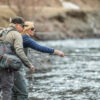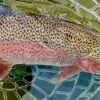“Failing to prepare is preparing to fail.” ~ John Wooden
It is as true in fly fishing as it is in basketball. A successful fly fishing outing is dependent on preparation. If you are planing on coming to the Sun Valley area, your preparation should include a visit to our store. Access to local knowledge about hatches, water levels, water temperatures, flies and techniques is paramount to your success on the water. Better yet, hire one of our expert guides and let him or her provide a hands on lesson. Good fishing in late August begins with preparation.
SILVER CREEK
With the shorter days and cool mornings, the Creek is already transitioning from a summer fishery into a fall. While there are still a few Triocs around, the late morning bug activity consists mostly of Baetis duns and spinners in size 22 and 24. The Callibaetis have gained momentum and can be found betweeen 2 and 3 in the afternoon in the slower stretches of the Creek along with a few blue damsels. Be sure to have a good selection of cripples, trailing shuck emergers, spinners, and duns in size 16 and 18 as the fish tend to feed selectively on specific phases of the Callibaetis depending on the day and conditions. Beetles, ants, and hoppers are also very effective, especially on the windy days. It is worth repeating that while fishing the Creek this season has been spectacular at times, the fishing in general remains spotty due to low water and erratic hatches. Much of the walk and wade portions of the Preserve are simply too shallow forcing most of the fish to seek the protection of deeper, cooler water.
BIG WOOD
The Wood continues to fishing well, but can be spotty. There are fewer fish in the Wood this year, and as a result it has been slow to rebound after it has received some fishing pressure the day before. The best fishing has been in areas well between the standard accesses. The water is low and clear, and the fish are starting to look for all kinds of late summer bugs from terrestrials, like flying ants and hoppers, to smaller Baetis and Tricos. With the low water, anglers need to be cautious when approaching the runs. The bigger fish are often waiting to ambush insects in the skinny water at the tail of runs or along the seams. Fish with light tippet (6X or 6.5X) and small parachute patterns before searching the deeper chutes with large dries and dry dropper rigs. This is a perfect water level to try out Tenkara if you have not yet given it a go. The length of a Tenkara rod gives you incredible control of your presentation and is a fun way to fish a single dry, a dry dropper, or a single nymph, Euro style. For flies, try small (12-16) yellow Stimulators, Parachute Hare’s Ear, Adams, or Purple Haze and for nymphs try a Rubber Legged Stone, Rainbow Warrior, Zebra Midge, or Bishop’s Dynamite.
WARM SPRINGS
If you love fishing small creeks, Warm Springs is just the place. As you work through a stretch of river keep in mind the fish will be concentrated in the deeper water and around cover. Be stealthy and you will have a chance of fooling the wily, wild fish. For beginners, Fish and Game keeps this river well stocked around the bridges. Fly wise, try yellow or orange Stimulators or Spruce Moth patterns for dries. Tying on a dropper is a good idea as well; Bishop’s Dynamite, Zebra Midge, Pheasant Tails, and Prince Nymphs all work well.
THE SALMON
The water is low on the Salmon opening up a lot of great walk and wade opportunities around the Stanley area. Along the wooded stretches of the river, look for a few Spruce Moths to be fluttering about. Whether you see them or not, try using a tan caddis or stonefly in size 14 to 8 trailed by a smaller beaded nymph like a Pheasant Tail or a Bishop’s Dynamite along the banks or in the shallow riffles above the deeper runs. Swinging black, brown, and olive streamers or buggers can also be productive and you might even find a resident Bull trout.
BIG LOST – MACKAY
The flows are down to just below 350 CFS. The flows should continue to drop as we head into September and the need to irrigate diminishes, so keep an eye on the Idaho Streamflow website. In the meanwhile, the wading remains somewhat challenging and the river can be difficult to get around. That said, these are the lowest flows we have seen all summer and lots of new water has opened as a result. The Trico and Baetis hatches have been very strong, but with the high flows, finding rising fish is a challenge. Nymphing is the most effective method. Try standard dry dropper rigs or fish Euro Style techniques. The best patterns include Rubber Leg Stones, San Juan Worms, and King Princes in the heavy runs. For the shallow water, try small nymphs like Zebra Midge, Bishop’s Dynamite, Beaded Pheasant Tails, and Rainbow Warriors in size 16, 18, and 20 below an attractor dry of your choice. If you find rising fish, have a good selection of high vis Tricos and Baetis. You might also try a dancing large crane fly pattern; we have a great selection of Mackay Specials.
UPPER BIG LOST
The water is skinny and cool on the Upper Lost. As a result, the best fishing has shifted from early mornings and late evenings right back to the middle of the day; classic fall fishing has already begun. With the low flows, the fish are typically concentrated in the deeper buckets, and anglers who are willing to walk from good holding water to the next are finding success. By the day’s end, if you have walked a few miles of river and have a handful of good fish, you have been successful. For flies, try small hoppers, caddis, stimulators and other small high vis attractors with a trailing nymph such as a Zebra Midge, a Bishop’s Dynamite, or a Beaded Pheasant Tail.
SOUTH FORK OF THE BOISE
The flows have been steady at around 1700 CFS all summer. It is prime time hopper fishing on the South Fork and working the banks with a variety of hopper patterns in a size 10 or 8 can be effective; however, the fish are quite selective. If you are getting refusals, try a different pattern. Small, tan crane flies are a good patten to try on selective feeders. Pink Alberts have been emerging in the late afternoon and offer a good opportunity to find some fantastic, but picky, fish on smaller dries and emergers. Nymphing is also very productive with large rubber leg stone fly patterns, caddis larva, and midge patterns.
STILLWATERS & LOCAL WATERS
Lake Creek, Penny Lake, or Gaver’s Lagoon have been stocked and will receive regular stockings throughout the summer season. These are great places for a family picnic or a fly fishing lesson. Whatever style of fishing you want to do, we are your headquarters, so drop on by and we will make sure you have the right gear to be successful.
|
Silver Creek Big Wood South Fork of the Boise The Salmon The Big Lost Copper Basin |
90 cfs 158 cfs 1690 cfs 433 cfs 316 cfs 35 cfs |




